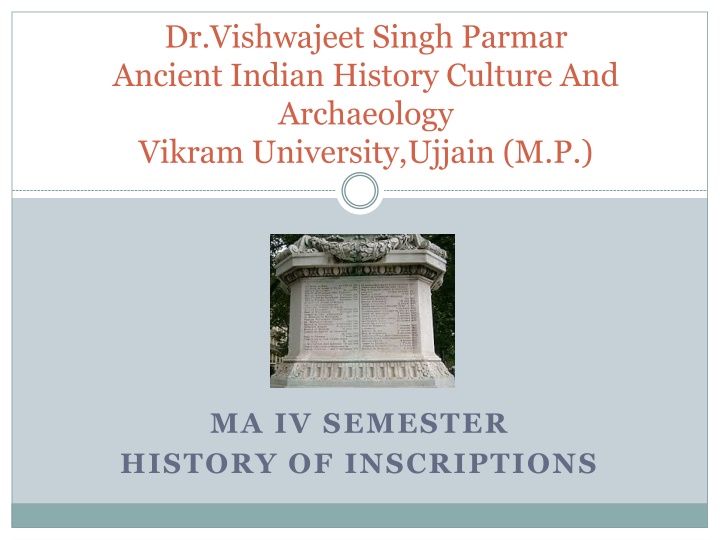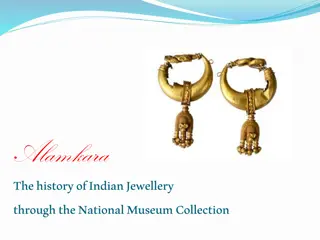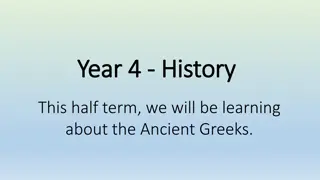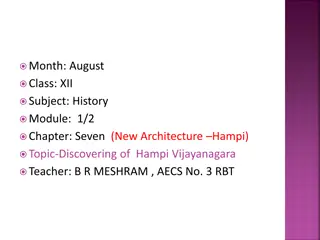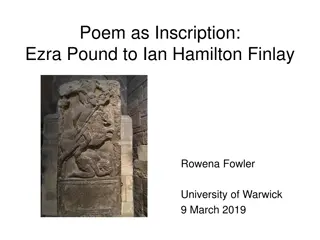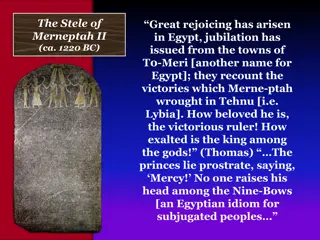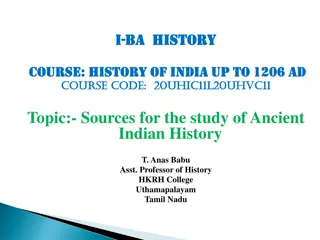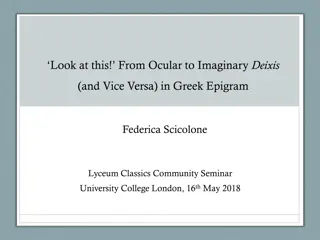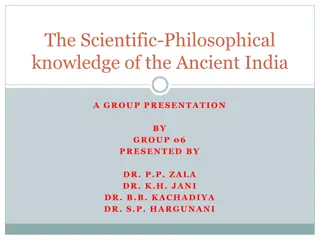Evolution of Inscriptions in Ancient Indian History
The evolution of inscriptions in ancient India reflects a shift from Prakrit to Sanskrit languages over the centuries, marking changes in content, purpose, and classification. Beginning with Brahmi inscriptions, the transition to Sanskrit gradually replaced Prakrit as the language of choice in Northern India. Inscriptions were classified based on surface, language, and purpose, with examples including Royal commemorative inscriptions and private dedicative records. Memorial stones were prevalent, honoring various individuals and events. This evolution highlights the rich historical and cultural significance of inscriptions in ancient India.
Download Presentation

Please find below an Image/Link to download the presentation.
The content on the website is provided AS IS for your information and personal use only. It may not be sold, licensed, or shared on other websites without obtaining consent from the author.If you encounter any issues during the download, it is possible that the publisher has removed the file from their server.
You are allowed to download the files provided on this website for personal or commercial use, subject to the condition that they are used lawfully. All files are the property of their respective owners.
The content on the website is provided AS IS for your information and personal use only. It may not be sold, licensed, or shared on other websites without obtaining consent from the author.
E N D
Presentation Transcript
Dr.Vishwajeet Singh Parmar Ancient Indian History Culture And Archaeology Vikram University,Ujjain (M.P.) MA IV SEMESTER HISTORY OF INSCRIPTIONS
Languages Of Ancient And Early Medieval Inscriptions The earliest Brahmi inscriptions, including those of Ashoka, are in dialects of Prakrit (also known as Middle Indo-Aryan). Between the 1st and 4thcenturies CE, many inscriptions were written in a mixture of Sanskrit and Prakrit. The first pure sanskrit inscriptions appeared in the 1stcentury BCE. The first long sanskrit inscription is the Junagadh rock inscription of the western Kshatrapa king Rudradaman.
By about the end of the 3rdcentury CE, Sanskrit had gradually replaced Prakrit as the language of inscriptions in Northern India. In the Deccan and South India, Sanskrit inscriptions appeared along with Prakrit ones in the late 3rd/early 4thcentury CE, for instance at Nagarjunakonda in Andhra Pradesh. The Sanskrit element gradually increased. In the transitional phase of the 4thand 5thcenturies, there were bilingual Sanskrit-Prakrit inscriptions as well as those in a mixture of the two languages. Thereafter, Prakrit fell into disuse.
Classification of Inscriptions Inscriptions can be classified in several different ways, for instance, according to the surface they are engraved on language, age and geographical region. They can also be classified into official and private records, depending on whose behalf they were inscribed. Ashoka s edicts and Royal land grants are examples of official records. Inscriptions recording grants made by private individuals or guilds to temples, or to Buddhist or Jain establishments are examples of private records.
Inscriptions can also be classified according to their content and purpose into types such as donative, dedicative and commemorative inscriptions. Lumbini pillar inscription of Ashoka is a Royal commemorative inscription, recording a specific event- the visit of the king to the Buddha s birth- place. In many parts of India, there is evidence of an Ancient practice of erecting memorials to dead people. Thousands of memorial stones are found all over the country, not always connected with burials.
Some only have sculpted scenes ( realistic or symbolic), others also have inscriptions. The most common memorial stones were erected in memory of dead heroes or women who committed sati. But there are other kinds as well. Stones were set up in honor of Jain men and women who gave up their lives in the exemplary Jain fashion of death by starvation. On the Konkan coast, many stones were erected in memory of sailors who lost their lives in sea battles. Some memorial stones were worshipped.
Donative inscriptions in favour of religious establishments were inscribed on shrine walls ,railings and gateways. The excavation and donation of caves to ascetics were recorded in inscriptions in the caves. Donative inscriptions include records of the installation of religious images, often inscribed on the image themselves. Others record investment of money made by people, out of the interest of which lamps, flowers, incense etc.,were to be provided for the worship of the Deity.
Royal land grants are an important category of donative records. There are thousands of such inscriptions, some on stone, but mostly inscribed on one or more copper plates. Most of them record grants made by kings to Brahmanas and religious establishments. The earliest stone inscriptions recording land grants with tax exemptions are Satvahana and Kshatrapa epigraphs found at Nashik. The mid 4thcentury Pallava and Shalankayana grants are the earliest surviving copper plate grants. One of the oldest copper-plate grants from North India is the late 4thcentury CE Kalachala grant of king Ishvararata.
Royal inscriptions include prashastis (panegyric). Most royal inscriptions (and some private ones too) usually begin with a prashasti, but some inscriptions are entirely devoted to eulogizing their subject .well known examples are the Hathigumpha inscription of Kharavela , the 1stcentury BCE/1stcentury CE king of Kalinga in Orissa and the Allahabad prashasti of the 4th century Gupta emperor Samudragupta .Certain inscriptions record the building of water works , wells and charitable feeding houses by private individuals .
A series of unique records of royal initiatives of this kind are inscribed on a granite rock at Junagadh (Girnar) in Gujrat. Apart from a set of Ashokan edicts,this rock bears two other important inscriptions . A 150 CE inscription of the Shaka ruler Rudradaman records the beginning of the construction of a water reservoir known as Sudarshan lake in the 4thcentury BCE during the time of the Maurya emperor Chandragupta , its completion during the reign of Ashoka , and its repair in Skandgupta, describes how the lake burst its banks due to excessive rains and was repaired after two years work .
Inscriptions as a source of History The text of inscriptions maybe brief , but a large number of short inscriptions can often provide important historical information . Inscriptions are a valuable source of information on political history. The geographical spread of a king s inscriptions is often taken as indicating the area under his political control . Their prashastis give details about the history of dynasties and the reigns of kings . Of course , there are problems . Royal inscriptions naturally tend to exaggerate the achievements of the ruling king.
Sometimes , confusion is created when a genealogy mentions kings with the same name, or when different inscriptions contradict each other on particular details . Inscriptions , especially those of the early medieval period , have been used as a major source of information on political structures and administrative and revenue systems . Inscriptions reflect the history of languages and litrature and a few references to the performing arts . For instance , the 7thcentury Kudumiyamalai inscription gives the musical notes used in seven classical ragas .
